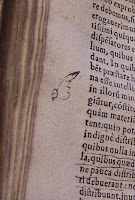 |
| Cat. Ref: N.2.15 |
As promised in
the last post, analysis of inscriptions and marginalia in the Cwm collection is
now underway, and it is hoped this will start to put some more flesh on the
bones of existing knowledge about the Cwm collection. Who used the books? Who
owned the books? How did they get to the Cwm? It is important to remember that
the Cwm collection is not just important for its religious significance, but also for its part in the history of the book and the early ideologiesof book collecting, with the earliest book in the collection dating from 1503.
With this in
mind, the analysis of any marks or inscriptions in the volumes themselves can
help to place the books individually, and the collection as a whole, in its
proper place in ‘book culture’, and start to piece together a rounded idea of
the Cwm Jesuit Library as a working collection of books.
Many of the
books have scribbles and notes in the margins, indicating that previous readers
have not only read the book, but have
engaged with the information contained within it by analysing it and noting its
significant points. This is often indicated by a particular mark in the margin
next to key pieces of text, much like an asterisk or similar. Many of these
take the form of the pointing hand (F), which William Sherman has termed ‘the manicule’in his recent fascinating book Used
Books: Marking Readers in Renaissance England (Philadelphia: University of Pennsylvania Press, 2008)
These
‘manicules’ are sometimes ready printed on to the page to draw readers
attention to a significant passage, or are drawn by the reader next to parts of
the text they found particularly interesting or useful:
 |
| Cat. Ref: U.3.8 |
 |
| Cat. Ref: U.16.2 |
Sherman also points out that these manicules were often personalised so that an individual reader could be identified from his annotations; such as the distinctive manicules of John Dee and Archbishop Matthew Parker (see Sherman, Used Books, pp.29-37)
 |
| Cat. Ref: U.4.20 |
 |
| Cat. Ref: U.3.8 |
There
are several varieties of ‘manicule’ featured in the Cwm collection, from the
printed (above) to the hand drawn, and they are extremely varied in detail, not
to mention anatomical accuracy! Some are very basic outlines, sometimes with
notes on the essential passage and key phrases underlined, whilst others are
more detailed, and others still are little more than arrows.
Another point worth noting is that the majority of readers seem only able to draw a manicule pointing to text on the right. The example above of the manicule pointing upwards is the only one in the collection; whilst the example below of the manicule on the right of the text it needs to point at only able to be drawn pointing
away from the text in the standard position.
Interestingly, the marginalia and manicules in
the Cwm collection seem to show that the books were used by a variety of
readers, who all felt the need to mark the text in their own way: at least 3 of
the examples shown here are all from the same book, and are more than likely
done by different readers, each engaging with the text in different ways and for different reasons.
 |
| Cat. Ref: U.3.8 |
More evidence from Between the Covers soon...
PS - All images are Ó Hereford Cathedral Library and Archives and should NOT be copied or used in any way. Thank you for your understanding in this.